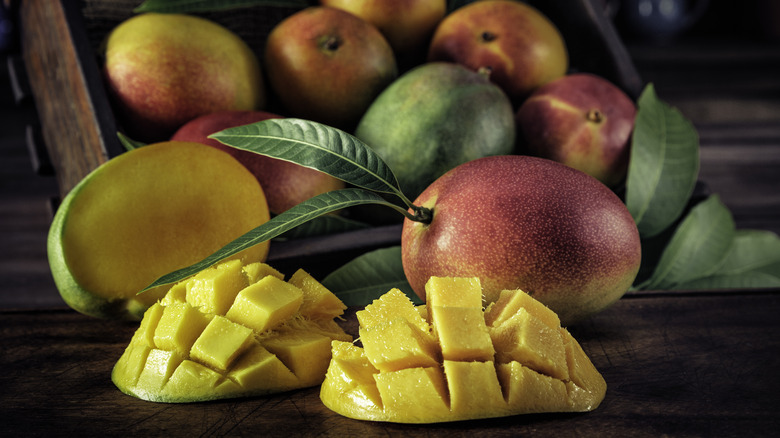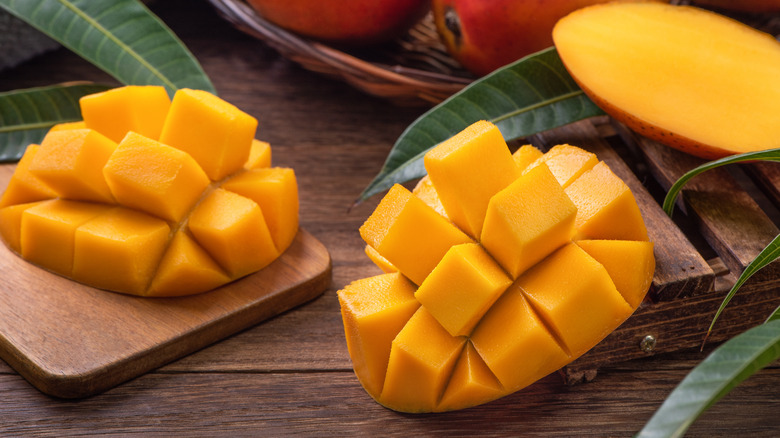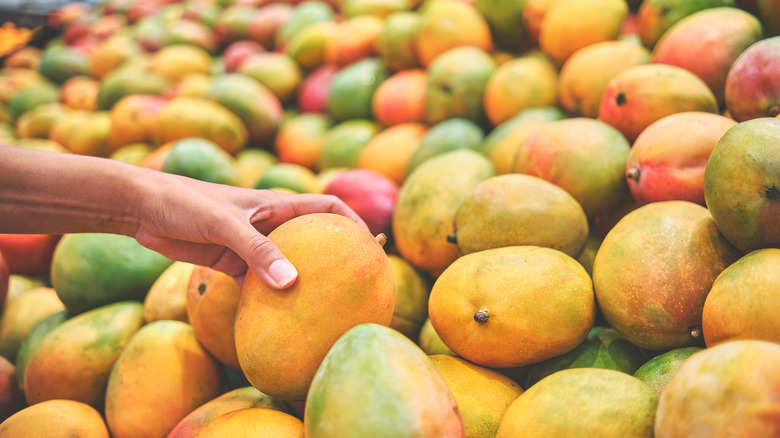The Best Way To Peel And Eat A Mango
Although it's worth the effort when you take that first juicy bite, mangoes can be tricky to peel. The fruit is classified as a drupe, like olives and stone fruit, and contains a long, flat pit in the center that needs to be cut around. Even though you are discarding the skin, make sure to wash mangoes (or any produce) before cutting or peeling to avoid introducing harmful bacteria to the flesh through the knife.
Start by identifying the stem and stand the fruit on a cutting board, stem up. Slice about ¼-inch from the center along the pit to remove the cheeks. Repeat this process on the other side. Then turn the mango 90 degrees and make two shallower cuts on each side of the pit. Use a vegetable peeler to remove any flesh clinging to the pit if necessary. Now you can start peeling the flesh from the skin.
Peeling a mango
Once the pit has been removed, the cheeks can be sliced or cubed by scoring a grid pattern into the mango's flesh with a paring knife, being careful not to pierce the skin. Press the skin with your fingers to push out the cubed flesh — which should resemble a porcupine — and use a spoon or paring knife to scoop out the mango for salsas and fruit salads.
Ripe mangoes can also be peeled into perfect halves using a wide drinking glass. Start by placing one end of a cut mango vertically on the rim of a thin glass. Now, slide the mango downward and into the glass, scraping the skin against the edge until you reach the bottom. The mango half should drop into the cup, and the skin — now separated from the flesh — should fall outside of the cup. A large spoon will also do the trick. Retrieve the fruit and cut it as you please.
If the skin is firm, whole mangoes can be peeled with a vegetable peeler and then cut around the pit before slicing into wedges. Use a paper towel to hold the slippery mango halfway through the process to keep the fruit from slipping in your hand. This method is difficult with overly ripe mangoes when the skin wrinkles — in this case, use a chef's knife instead.
How to pick a ripe mango
While mangoes are safe to eat at all stages of ripeness (unlike their tropical cousins, papaya), the fruit is the sweetest when ripe and can be sour or tart when unripe. To enjoy the fruit raw, choose a plump and fragrant mango, as shown in the video above. Disregard its color since mangoes come in various shades. Similar to peaches, mangoes will get softer as they ripen.
Ripe mangoes, like an avocado, should give a little when pushed with your thumb. An unripe mango will be hard to the touch but ripen in a few days on the countertop, whereas a mushy mango should be avoided and will likely attract fruit flies before you put the groceries away.
Place unripe mangoes in a paper bag with apples or bananas to expedite the process. The ethylene released by those fruits will speed up the ripening. Mangoes should be stored at room temperature on the counter until ripened. Cut mango and whole ripe mango can be placed in the refrigerator for up to five days to keep it fresh or frozen for six months.



